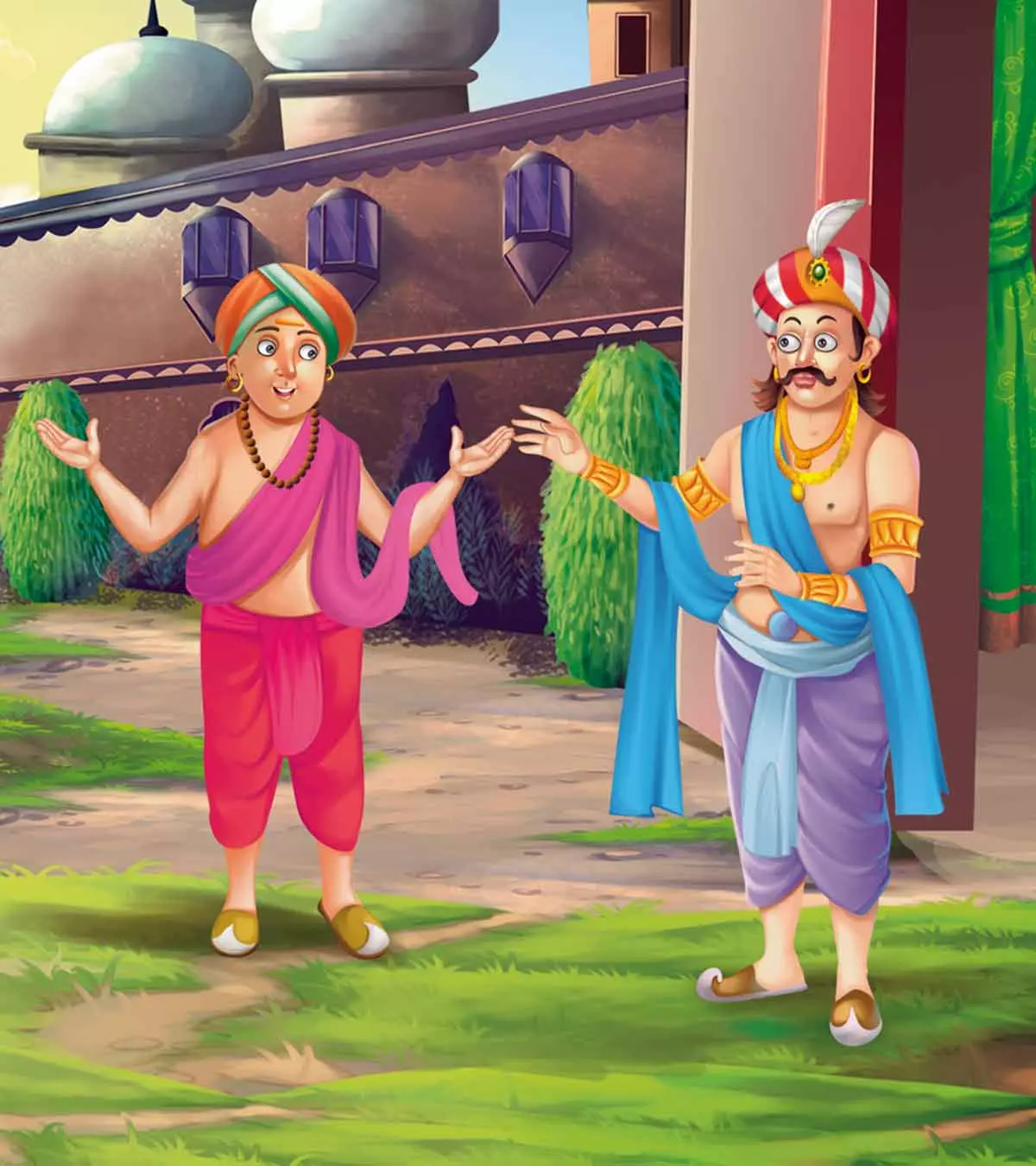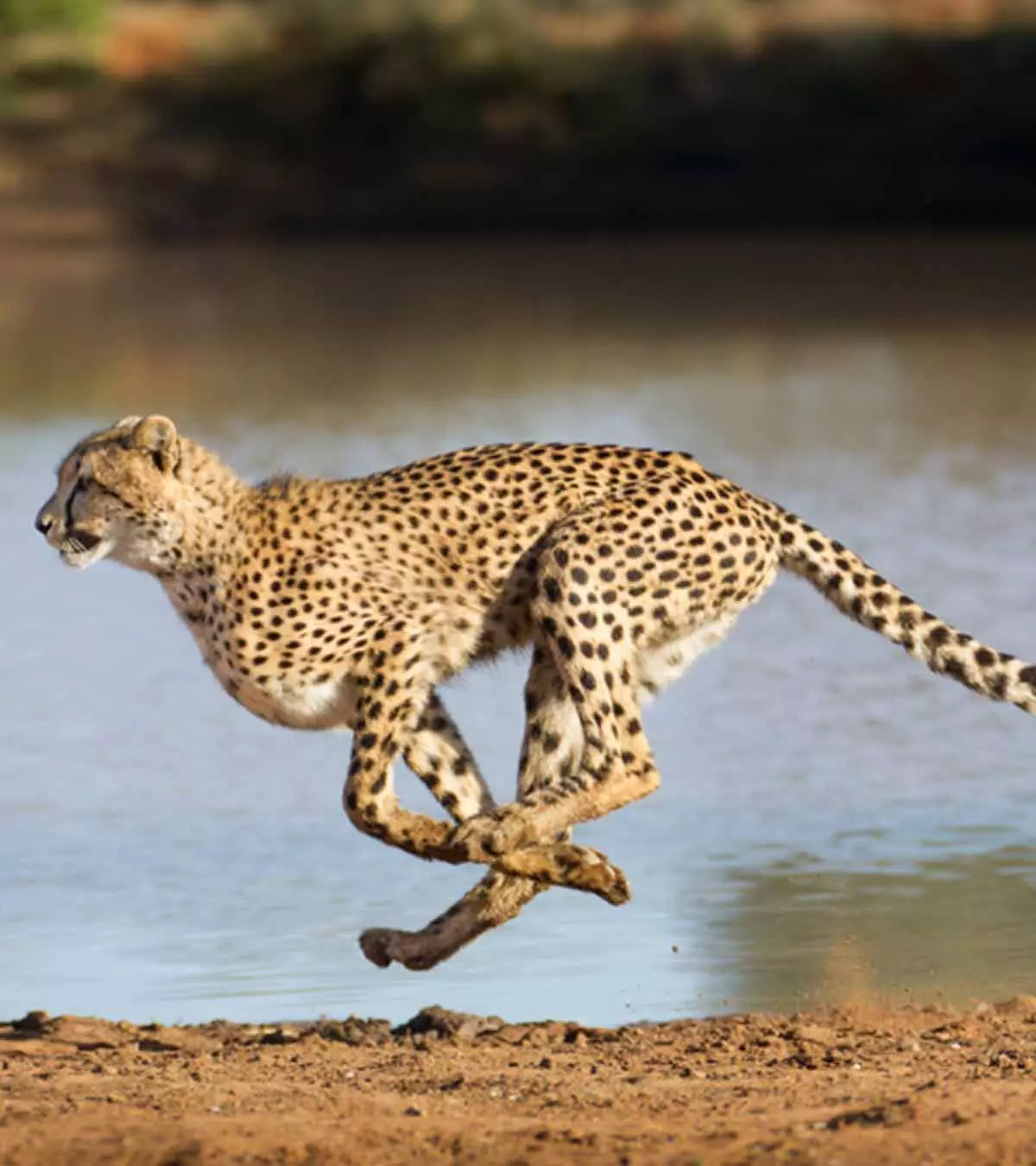
Image: Shutterstock

We all know that cheetah is the fastest animal. But there are specific facts about cheetahs for kids, which can help your child learn much more about this striped animal. For example, your kids would love to know that the scientific name for cheetah is Acinonyx jubatus and that the word cheetah has been derived from the word Chitraka, which in Sanskrit means “the spotted one.” Read on to learn more interesting facts about this endangered and graceful animal, including its characteristics, habitats, and behavior.
Key Pointers
- A cheetah is a large wild cat often confused with leopards.
- They don’t roar but purr to communicate with each other.
- They are adaptable to different habitats, eat small antelopes, and more interesting facts about Cheetah for kids just a scroll away.
20+ Cheetah Facts For Kids
1. Cheetahs belong to the cat family
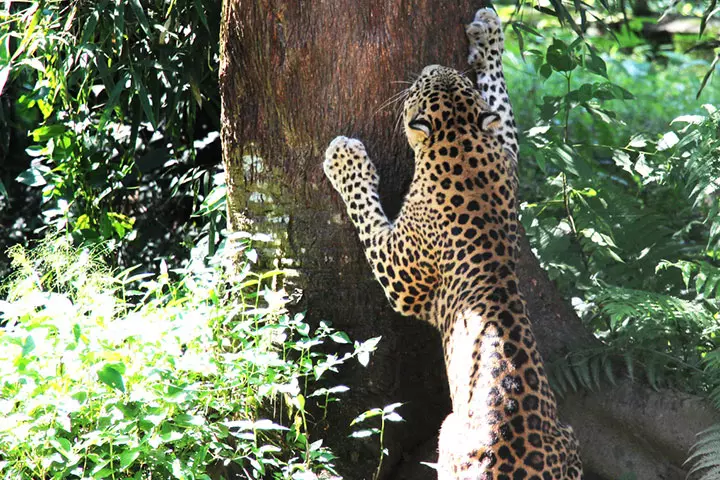
Image: IStock
Did you know that cheetahs are comparatively smaller than other wild cats? They weigh only about 45–60kg. Lions, Leopards, and Jaguars are all larger and heavier than cheetahs. Cheetahs are often confused with leopards, but they have long black stripes on their face, and their spots are much rounder. And, unlike the other cats, cheetahs lack the ability of climbing trees.
2. Male cheetahs usually live in groups
Cheetahs are generally social by nature and tend to live in groups. The female cheetahs stick with their cubs for up to a year or two, while the male cheetahs typically form a group known as a “coalition” and hunt together. The female cheetahs are solitary animals except when they are raising their cubs.
3. Cheetahs give birth to a litter of cubs
A female cheetah gives birth to anywhere from two to five cubs at a time. The cubs stay with the mother until they are about 16 to 24 months old (1).
4. There are different types of cheetahs
While there are four subspecies of the cheetah based on the geography in which they are found, there are as many as 36 species of cheetahs.
5. Cheetahs rarely drink water
Although they don’t have a hump, cheetahs are similar to camels. They don’t drink a lot of water! Cheetahs derive their fluid requirement from the food itself and usually drink water only once in three to four days!
6. Cheetahs are adaptable to different habitats
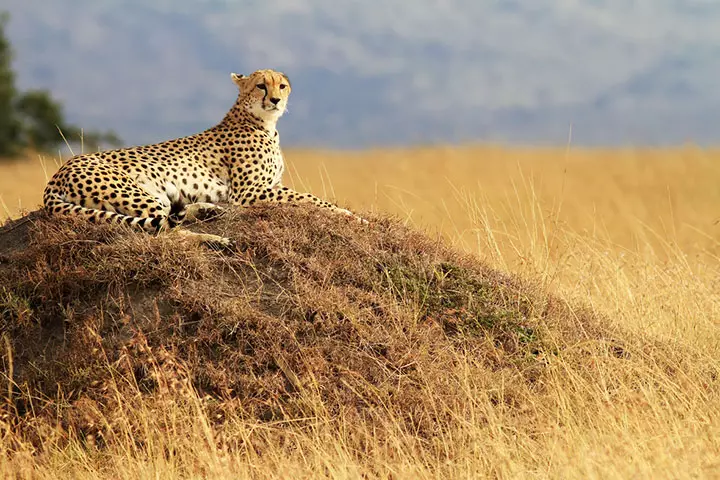
Image: Shutterstock
Cheetahs have a remarkable adaptation to their environment, as they are not as picky about their habitats as other cats. They can be found in any area with prey, good visibility, and fewer larger animals. Open grasslands and savannas are their preferred habitats, but they can also thrive in semi-arid regions and adapt to changing environments when necessary. They have been known to inhabit areas at elevations as high as 4,000m (13,000ft), too.
7. Cheetahs have unique spots
A fully grown cheetah’s body can have anywhere between 2,000 to 3,000 spots! The pattern of spots on each cheetah’s body is unique, much like our fingerprints, and these spots help them camouflage during a hunt.
8. Cheetahs are competent hunters
Cheetahs have lightning speed and excellent vision, making them natural and competent hunters. In the Middle East, cheetahs would even accompany the royal hunt expeditions in the 7th century AD.
9. Cheetahs can run at great speed
The fastest creature on land can reach a speed of up to 70 miles per hour in just three seconds! The cheetah’s elongated spine and vertical shoulder blades allow it to stretch by as much as 30 feet. Besides its speed, a cheetah can also change direction mid-air during a chase! However, it does not have a lot of stamina and can only maintain top speed for a minute or two (2).
10. Cheetahs have tear marks
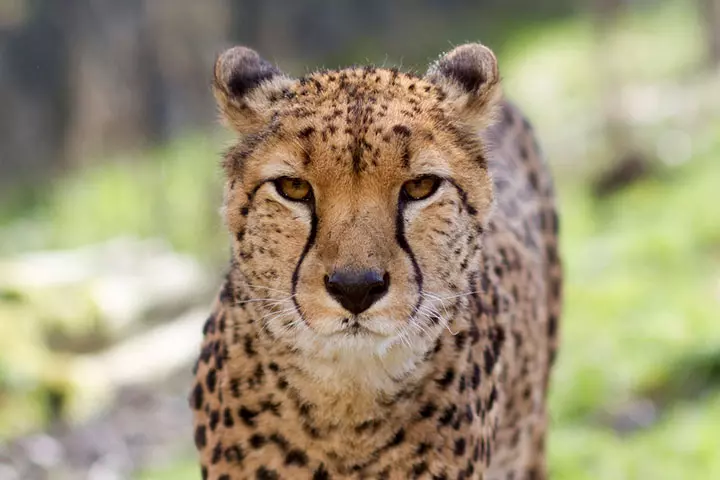
Image: IStock
Cheetahs have long black lines from their eyes to their mouth, called tear lines. It is believed that these protect them from the sun’s glare and give them a clearer long-distance vision. This enables them to spot their prey from a distance of up to five kilometers (3).
11. Cheetahs hunt during the day
Cheetahs are excellent hunters, thanks to their athleticism and eyesight. However, they usually hunt only during the day, unlike other larger animals, as they have poor night vision.
12. Cheetahs choose smaller prey
Given their relatively smaller size, cheetahs prefer to hunt smaller prey. However, when hunting in groups, they are capable of hunting larger prey, too. Unlike other cats, they stalk their prey for only a short while and chase them for about 30 seconds.
13. Cheetahs eat quickly
Cheetahs usually eat soon after the hunt. Just like their speed during the hunt, cheetahs eat fast as well. This is mostly due to threats from other carnivores, such as hyenas or lions that share the same habitat.
14. A cheetah’s tail gives it direction
A cheetah’s tail can be as long as 80 centimeters and tends to be rather flat. The long tail aids the cheetah in steering and changing direction while running. It acts as a rudder on a boat, especially at high speed!
15. Cheetahs are not aggressive
Although they are predators, cheetahs are not naturally aggressive. In fact, they try to avoid larger prey, and if threatened by larger prey, they tend to give up rather than engage in predation.
16. Cheetahs were once kept as pets

Image: Shutterstock
Cheetahs have served as hunting pets of humans from about 3,000 BC. Today, however, it is illegal to have this animal as a pet in several countries.
17. Cheetahs don’t roar
It may be hard to believe, but cheetahs do not roar. They usually purr while they are grooming or are around other cheetahs. They also communicate with each other by making small chirping sounds. Who knew cheetahs would have something in common with birds!
18. Cheetahs are a threatened species
Cheetahs were heavily distributed all over the world about 20,000 years ago. However, it is estimated that there are less than 7,100 adult and adolescent cheetahs in the wild today. The current conservation status of cheetahs is “Vulnerable” on the International for Conservation of Nature (IUCN) Red List. They are threatened by several factors such as habitat loss, conflict with humans, and poaching.
19. Cheetahs live long
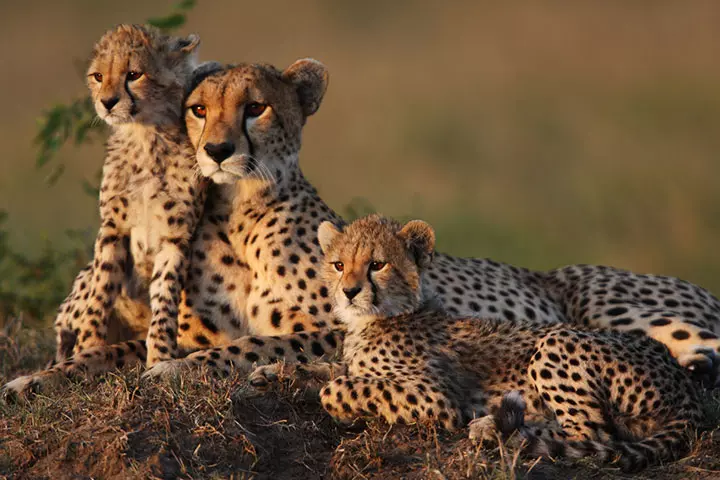
Image: IStock
Cheetahs usually live much longer than other wild cats, such as lions. While a lion has an average lifespan of about 10–14 years, cheetahs have been known to survive for more than 17 years!
20. The King Cheetah has been spotted for less than ten times
The Cooper’s Cheetah, also known as the King Cheetah, was first spotted in 1926 and has since been found in the wild only about five times. It is an African Cheetah with a rare fur pattern. The spots are blotchy, and three full-length black stripes run from the neck to the tail.
21. The cheetah is one of the oldest species in existence
21. The cheetah is one of the oldest species in existence
Frequently Asked Questions
1. Where does a cheetah sleep?
Cheetahs prefer to sleep under large shady trees that offer protection (1).
2. How many hours does a cheetah sleep?
On average, cheetahs sleep for around 12 hours a day (2).
3. Why is cheetah conservation important?
Cheetah conservation is important because cheetahs are apex predators who help control herbivore populations, which, in turn, helps maintain the health and balance of grassland ecosystems by preventing overgrazing.
4. How can we help protect cheetahs in the wild?
You can support conservation organizations working to preserve their habitats via donations and volunteering. Contribute to anti-poaching efforts and promote sustainable practices that reduce human-wildlife conflict. Engage in responsible tourism and promote conservation efforts to ensure the long-term survival of this endangered species.
5. What are cheetahs’ weaknesses?
Cheetahs have weaker jaws and smaller canine teeth than other large predators, such as lions, making them vulnerable during confrontations with stronger animals. They also have low genetic diversity, which increases their susceptibility to diseases and reduces their adaptability to environmental changes.
6. Can cheetahs swim?
Yes, cheetahs can swim and are relatively strong swimmers. However, like other cat family members, they are hesitant around water.
Children love exploring and learning new facts. Therefore, sharing these facts about cheetahs for kids with your little one will pique their curiosity. You can encourage children to draw or use cheetah coloring pages to engage them further and help them visualize the animal as they learn about it. Facts, such as cheetahs rarely drink water, accelerate faster than a Ferrari, and are friendly toward humans, are intriguing. Knowing about these facts would not only help children appreciate the animal more but also improve their general awareness of the diverse wildlife on the planet. In addition, reading and sharing these facts with friends and family will be a good way to enhance knowledge and add fun.
Infographic: Amazing Cheetah Facts For Children
Cheetahs are large cats known for their lightning speeds. The next time you take your children to the zoo and they ask about this stunning animal, share the interesting facts from our infographic below to satisfy their curiosity. These facts may also intrigue the children to know more about cheetahs and other wild animals.
Some thing wrong with infographic shortcode. please verify shortcode syntaxIllustration: Fun And Interesting Facts About Cheetah For Kids

Image: Stable Diffusion/MomJunction Design Team
Fascinating facts about the fastest land animal, perfect for kids to explore. Discover why cheetahs are so special!
References
- About Cheetahs.
https://cheetah.org/learn/about-cheetahs/ - What sleeping animals can tell us about our sleep.
https://qbi.uq.edu.au/blog/2018/02/what-sleeping-animals-can-tell-us-about-our-sleep - Adrienne E Crosier et al. (2025); First Birth of Cheetah Cubs from In Vitro Fertilization and Embryo Transfer.
https://www.researchgate.net/publication/344485003_First_Birth_of_Cheetah_Cubs_from_In_Vitro_Fertilization_and_Embryo_Transfer - 5 remarkable animal moms.
https://www.worldwildlife.org/stories/5-remarkable-animal-moms
Community Experiences
Join the conversation and become a part of our nurturing community! Share your stories, experiences, and insights to connect with fellow parents.
Read full bio of Beth Sullivan
Read full bio of Sravani Rebbapragada
Read full bio of Harshita Makvana
Read full bio of Praggya Joshi













